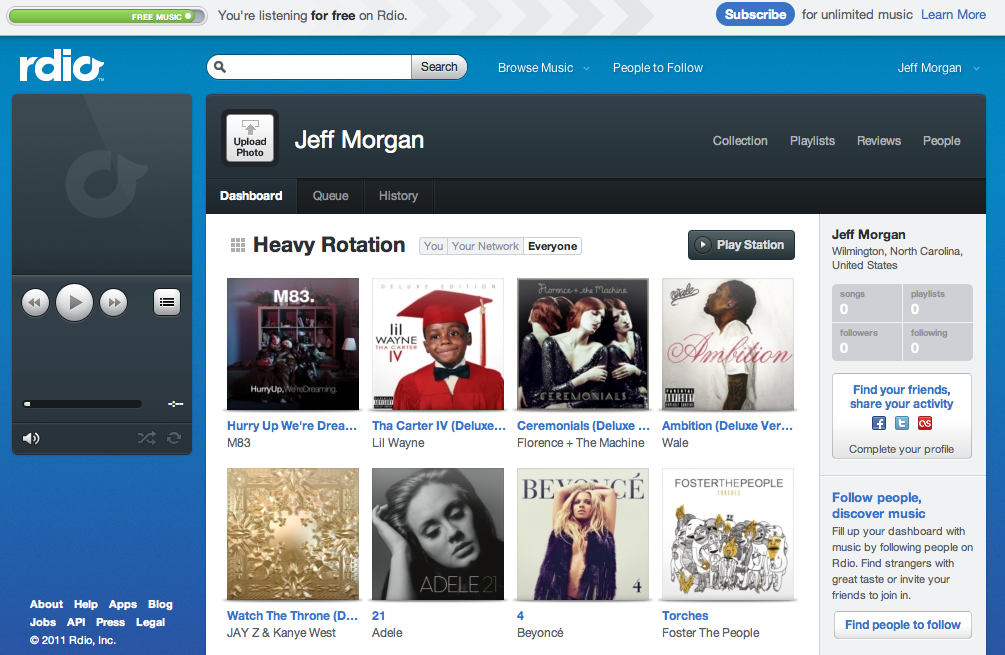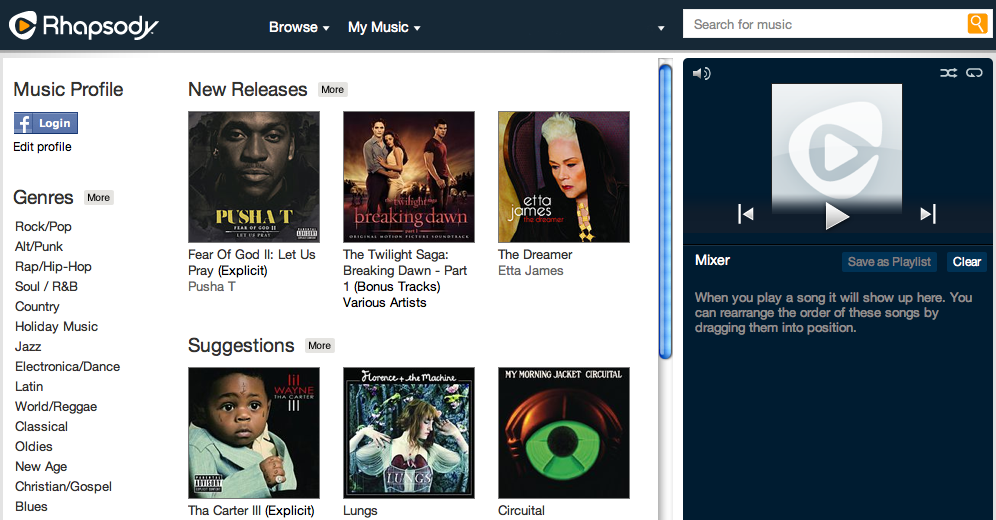Which music service is right for you?
The ways we enjoy music have changed so much over the last decade that it’s almost impossible to keep pace with the industry. The latest obstacle we had to overcome was the storage problem – where do I keep those gigs an gigs of music I’ve acquired over the years? Now we’re moving away from acquisition altogether, hurtling instead toward a musical world in which we rent someone else’s library month-by-month for a flat fee. And you know what? I love it.
I know. For a lot of music freaks that sort of concession is cardinal sin, but it works for me. I’m not the type to savor rare recordings and unplugged albums. I want quick access to a wide range of music, and that’s exactly what today’s streaming services give me. The good ones also provide some ways for me to discover new music without a whole lot of work. I know, I’m lazy. I’m exactly what true music lovers hate. I’m little more than a parasite feeding off the knowledge and expertise the real fans have taken years to cultivate. But hey, at least I’m aware of it, right?
This post is for people like me, the average music enthusiast. I’ve spent some time with the major streaming services out there and come away mostly impressed. I’ll breakdown the good and bad of each and, hopefully, give you some guidance on your quest for the perfect streaming service.
The Basics
There are some basic criteria we need to be clear on before I talk about specific services. For one, this isn’t exactly an oranges-to-oranges comparison. Each of the major streaming services is trying to differentiate itself from the other. Any streaming service should be able to provide the basics, though, which look a little something like this.
First, selection. When you give up the search for hard copies of music, streaming selection becomes hugely important. Your streaming service should be able to provide music that suits your tastes, and hopefully a few things that don’t. You know, just in case you get bored.
Second, user interface. Both finding and accessing your music should be quick and easy. That’s the whole point of a streaming service – quick, easy access to a vast supply of audio pleasure.
Lastly, access. What’s the point of a streaming service if you can’t access it from multiple devices? If digital music can be on your home machines, your phone and in your car, your streaming service should be able to do the same, preferably with some offline functionality in the event you’re away from an internet connection.
Rdio
Rdio was my first streaming experience, and it wasn’t a good one, at least not at the start. I signed up for a trial just before Arcade Fire released its Grammy-winning album “The Suburbs,” which Rdio didn’t have. A quick search for some other popular or rising artists returned similar results. Granted, Rdio was open about the problem. There were newsletters saying they were striking deals to increase their offering, but they violated the selection rule and were pretty much out for me.
Still, I had a hard time letting Rdio go. Its user interface remains one of the best on the market. There aren’t extra windows to manage for the player, I can browse quickly from artist to album to track and off to similar artists if I want to do some exploration. Rdio also has a “follow” function similar to Twitter, allowing listeners to follow popular people or brands and listen to the music they’re listening to.
I went back to Rdio for a bit while writing this article. The selection is vastly improved and the UI remains just as good as it always was. Rdio has moved to a limited-free model of listening. You can only listen to so many songs before your free-time runs out and you’re implored to buy a subscription. Subscriptions start at $5/month for the basic unlimited plan. Mobile access will cost you $10/month.
With those things in mind I dove into four of the most popular music streaming services available.
MOG
After leaving Rdio I fled to MOG and actually stayed there for a while. This was before Spotify launched. For $10 a month I had unlimited mobile access, a decent user interface, and great selection.
That’s not to say MOG didn’t have its pitfalls. The UI wasn’t great, and linking friends to the songs I was listening to was often a pain in the ass. That has since changed – the UI got a facelift shortly after Spotify launched. The service also moved from pay-only to a limited-free scenario, similar to Rdio. With MOG, users have a limited amount of free music per month, which can then be increased by inviting friends to join MOG or exploring music.
I want to take minute to talk about this one in-depth. The service is free, but only free if you tell your friends you’re using it, save playlists, and generally try to find music you don’t typically listen to. I’m all for incentivizing exploration, but at the cost of free music it kinda sucks. Yes, it’s great advertisement – everyone loves word of mouth – but is that really better than the unlimited-free, ad-supported version offered by Spotify? Not for me. Remember, I use streaming music services because I’m a lazy music consumer, and maybe that makes me the strange one, but I don’t want to manage MOG as though it’s another social network. Anyone remember another music-based social network? Does that Ping a bell (sorry, I had to)?
That note aside, MOG does have the best exploration tools of any of the streaming services, if only because it works without much effort. Want to hear a range of artists like the one you’re listening to? Move the slider at the top of your playlist to “Similar Artists.” The slider offers a variable mix, so you can hear mostly The Raconteurs with the occasional similar tune thrown in, or cast a wide, Jack-White-esque net. It’s like on demand Pandora with a variable resistor. It’s great.
MOG runs the same subscription service most others do at this point. It’s $5 for unlimited computer access, $10 for the same plus mobile access.
Spotify
Spotify is the gorilla of the streaming music industry, even if they just made the jump across the pond. Spotfiy got started in Sweden and was the envy of music lovers stateside until its US launch this past July. Spotify does a lot of things well, not the least of which is offering unlimited free service, provided you’re willing to put up with ads. Spotify is also the reason MOG, Rdio, and pretty much anyone else in the game went to a limited-free model. Spotify pioneered the $5-at-home, $10-on-the-road model of subscriptions as well, which have been adopted by other providers.
Spotify is far from perfect, though. Of the three listed so far, Spotify might be the worst at encouraging and supporting exploration. The best you get from the Spotify client is a grid view of similar artists, and getting there from, say, a searched album takes more clicks than it should.
If you don’t like ads, you’re going to hate the free version of Spotify. Ads play between every few songs, often back to back. The flipside, of course, is unlimited free listening. Spotify also rocks for people with an established library. The service allows users to sync streamed playlists and hard copy playlists to a mobile device (with a subscription plan), so you don’t lose the collection you spent so much time building. Spotify also has offline playlist support for the $10/month crowd, which is solid.
As I mentioned before, Spotify pioneered the streaming costs the other networks now share. $5/month for at-home listening, $10/month for mobile, which includes offline playlist support.
Rhapsody
The good people at Rhapsody hooked me up with a free month of service, which is basically why I decided to write this article. To be fair, I hadn’t given Rhapsody much of a shot until now. I didn’t really have a reason. It was the same price as the other services, although it is more family friendly (their top plan gives one account access on three mobile devices). It seemed to have similar selection. In short, there was no real differentiator (other than that family plan).
Today, Rhapsody is different, but it isn’t all good. You’ll notice that Rhapsody is lacking the free and $5 plan. If I had to pick just one thing the service could improve upon, this would be it. Choosing a streaming service is still a big decision for a lot of people. Diving in at the $10-15/month level won’t be an easy sell. I know there’s a 14-day trial, but 14 days probably isn’t enough for a serious music consumer to figure out whether a service – any service – is going to work out.
Despite that small oversight, Rhapsody does a lot of things well. Their radio is at least as good as its competitors’ and probably my favorite feature. It is missing some of the exploratory functions of MOG’s radio, but in my experience the selection seemed a little better. Rhapsody also has the best listening history feature by a long shot. I’m not always paying full attention to what I’m listening to, so it’s nice to go back and find that song with the great hook.
So Which Service Do I Choose?
This is going to sound like a cop-out answer – to be honest, that’s sort of what it is – but you need to try them out. I’ve highlighted the good and the bad features of each, but the reality is, the services are pretty similar. At this point it comes down to taste. I will say this: If you want a service for your family, go with Rhapsody. It’s easily the best option for more than one person. If you have a tiny circle of artists you love but want to branch out, look into MOG. Their exploration features are the best out there. If you want to listen to unlimited music without paying a dime, Spotify’s the right pick.
At the end of the day, music is about more than just one decision or one feature. There will be all kinds of things you start to notice when you use these services for thirty days or more. The best way to find your service to is try one. Don’t like it? Move on. I’m sure there’s something out there for almost everyone.
Related Posts
You can follow us on Twitter and Facebook for content updates. Also, sign up for our email list for weekly updates and check us out on Google+ as well.
Posted in: Music
Tags: cloud music, mog, mog.com, rdio, rhapsody, spotify, streaming, streaming music, streaming services















